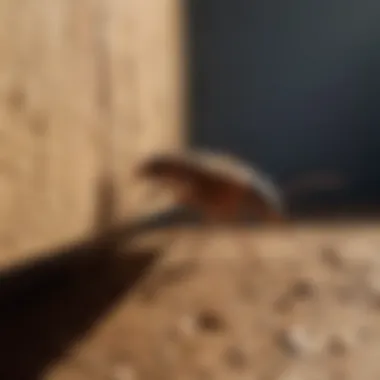Do Termite Stakes Work as Pest Control Solutions?


Intro
Termites pose a significant threat to homes. Their often unseen work can lead to serious damage, making an effective pest control method necessary. One popular option among homeowners is the use of termite stakes. This article will explore the effectiveness of these stakes. We will analyze how they work, their advantages and disadvantages, and practical tips for their use. By the end, readers will gain a deeper understanding of whether termite stakes are a suitable solution for their homes.
Pest Identification
Before using termite stakes, it is essential to identify the type of termite present. The two most common types are subterranean termites and drywood termites.
Subterranean Termites: These insects live underground and build mud tubes to travel between their nests and food sources. They often infest wooden structures by tunneling through the wood.
Drywood Termites: Unlike subterranean species, these termites do not require contact with the soil. They live within the wood they infest, making them more difficult to detect.
Signs and Symptoms of Infestations
Homeowners should look out for several signs that indicate a termite problem:
- Mud tubes along foundation walls or wooden structures.
- Hollow-sounding wood when tapped.
- Discarded wings near windows or doors, particularly after swarming season, which typically occurs in spring.
- Frass, which appears as tiny wood-colored pellets beneath infested wood.
Identifying termites early is crucial for effective treatment. Waiting too long can lead to extensive damage.
Prevention Strategies
Preventing termite infestations is more effective than treating them. Here are some strategies homeowners can implement:
Home Maintenance Tips for Pest Prevention
- Eliminate Moisture: Repair any leaks in plumbing or roofing, as termites are attracted to moisture.
- Proper Drainage: Ensure that gutters and downspouts direct water away from your home's foundation.
- Seal Cracks: Caulk openings, such as gaps around pipes and in walls, to prevent entry.
Natural Deterrents and Barriers
- Boric Acid: This natural insecticide can be applied to infested wood to deter termites.
- Nematodes: Beneficial nematodes can be introduced into the soil to help reduce termite populations.
- Barrier Treatments: Installing physical barriers like steel mesh or sand barriers can help limit termite access to your home.
Treatment Options
If infestations are already present, it’s important to consider various treatment options.
Overview of Chemical vs. Natural Treatments
- Chemical Treatments: Chemicals such as fipronil and imidacloprid are common in traditional pest control. They kill termites on contact and through ingestion.
- Natural Treatments: Options like orange oil or neem oil can also be effective, although they usually take longer to work.
Step-by-Step Guides for DIY Treatments
- Identify the Infestation: Confirm the presence of termites through the signs discussed above.
- Select the Treatment: Based on your preference for chemical or natural options, choose an appropriate method.
- Apply the Treatment: Follow the instructions carefully. For example, if using a chemical, make sure to wear protective gear.
Proper treatment and maintenance can effectively manage termite infestations, but prevention should always be the primary focus.
By understanding the effectiveness of termite stakes alongside these considerations, homeowners can take informed actions. Through careful monitoring, prevention, and treatment, the threat of termite damage can be significantly reduced.
Understanding Termite Stakes


Understanding termite stakes is crucial for homeowners facing potential infestations. It illuminates how these tools contribute to pest control and promotes informed decision-making. In this context, termite stakes are a key component of modern pest management techniques. This section will clarify their definition, purpose, and functional mechanics, enabling readers to appreciate their place in overall property protection.
Definition and Purpose
Termite stakes are specialized devices designed to prevent and control termite infestations in residential properties. Typically made of wood or plastic, these stakes are inserted into the ground around the perimeter of a home. The primary purpose of termite stakes is to act as a barrier against termites, either by delivering chemical treatments or utilizing bait systems.
Originally, termite stakes were designed to provide a physical barrier. However, their development has expanded to include various types with differing functions and benefits. The effectiveness of these stakes depends significantly on proper placement and ongoing monitoring. Understanding this definition helps homeowners grasp why termite stakes can be an integral part of their pest control strategy.
How They Function
The functionality of termite stakes is rooted in their design and the methods used to manage termite activity. When stakes are installed, they can either release chemicals, which are toxic to termites, or provide bait that attracts these pests. Here’s a closer look at how they work:
- Chemical Stakes: These stakes contain termiticides that gradually release into the surrounding soil. When termites come into contact with this treated area, they absorb the chemicals, leading to their eradication. This method offers a long-term solution since chemicals can persist in the soil for extended periods.
- Baiting Systems: In contrast, baiting systems rely on attracting termites to the stake, which contains a substance that interferes with their growth or reproduction. While this strategy may take longer to show results, it reduces chemical exposure and targets the termite colony more effectively.
Proper understanding of how termite stakes function is essential. It aids homeowners in recognizing their purpose, assessing products based on efficacy, and implementing them properly for optimal results.
"Understanding the specific mechanics of termite stakes empowers homeowners to make informed choices regarding pest management strategies."
The stakes serve not only as physical barriers but also as essential tools in a homeowner's arsenal against termites. This understanding reinforces the importance of using termite stakes while considering their advantages and limitations in real-world applications.
Types of Termite Stakes
Understanding the various types of termite stakes is crucial for homeowners considering pest control options. Each type uses distinct methods to combat termite infestations, offering different benefits and considerations. This section will delve into the three primary categories of termite stakes: chemical termite stakes, baiting systems, and natural or organic alternatives. Each has its unique features and appropriateness depending on specific situations and preferences.
Chemical Termite Stakes
Chemical termite stakes are widely utilized for their efficacy in soil-based termite control. These stakes contain pesticides designed to attract and eliminate termites. When placed in the ground, they slowly release the active chemicals, creating a protective barrier around your home’s foundation. The termites consume the treated material, leading to a decline in their population.
One of the advantages of chemical stakes is their long-lasting effectiveness. These stakes can remain functional for several years, depending on environmental conditions and the specific product. However, careful consideration should be taken regarding the chemicals used, as they may pose risks to pets and children. Homeowners must tap into the label's guidelines that detail safe usage instructions and potential hazards.
Advantages of Using Termite Stakes
Using termite stakes offers homeowners several benefits that are crucial in the fight against termite infestations. Understanding these advantages can help in making an informed decision about pest management strategies. Termite stakes are designed to be placed in the ground around a property, where they serve as a bait and monitoring system. This targeted approach can lead to effective termite control, minimizing the overall risk of damage to structures, and providing peace of mind.
Targeted Application
One of the key benefits of termite stakes is their targeted application. Unlike broad-spectrum chemical treatments that may affect beneficial insects and the surrounding ecosystem, termite stakes focus specifically on areas where termites are most likely to be active. This means that the risk of harming non-target species is significantly reduced. Moreover, stakes can be strategically placed near physical evidence of termite activity, such as mud tubes or wood damage. This localized treatment increases the efficiency of baiting systems and enhances the probability of eradicating infesting colonies.
"Targeted application is key for effective pest control strategies, aiming precisely at the source of the problem rather than dispersing chemicals broadly."
Long-lasting Protection
Another advantage is the long-lasting protection termite stakes can offer. Many products are created using durable materials that can endure weather and environmental degradation, ensuring that they provide ongoing protection for extended periods. Some baiting systems contain slow-acting toxins that, when consumed by termites, are transferred to the colony. This slow action allows for a more sustainable elimination of the pests over time, rather than a quick fix that leaves behind surviving members that can repopulate. Consequently, the use of these stakes can contribute to long-term defense against infestations, saving homeowners money on future treatments and repairs.
Reduced Risk of Chemical Exposure
Lastly, termite stakes present a significant reduction in the risk of chemical exposure. Many homeowners are understandably concerned about the potential health risks associated with the application of traditional pesticide methods around their living spaces. Termite stakes provide a solution that minimizes this risk, as their formulation can be less toxic than conventional pest control options. This is particularly important for households with children or pets, as safety becomes a primary consideration. By using well-placed bait systems, occupants of the home can feel at ease knowing that they are protected from harmful chemical exposure while still addressing a serious pest problem.
In summary, the advantages of using termite stakes lie in their targeted application, long-lasting protection, and reduced health risks. These features make them an appealing option for homeowners looking for effective pest control solutions.
Disadvantages of Termite Stakes


When discussing termite stakes, it’s essential to evaluate their disadvantages. Although many homeowners consider termite stakes for controlling pest problems, understanding the potential drawbacks can lead to better decision-making. The effectiveness of these stakes can be influenced by various factors, each with its own unique implications.
Cost Considerations
The financial aspect of termite stakes is a critical factor to consider. While they can be an effective preventive measure for termites, the initial investment may be higher compared to other treatments. The cost may include not just the stakes themselves, but also installation, monitoring, and potential follow-up treatments.
Many homeowners may find that the ongoing costs for maintenance can add up over time. If the stakes need to be replaced or additional treatments are necessary, the original expense can multiply. Considering these costs is vital before committing to this method of termite control. Also, it might not be the best option financially when compared with other alternatives.
Maintenance Requirements
The success of termite stakes is tied to regular maintenance. Most types need periodic checking and potential replacement, which can be a hassle. Homeowners must remain vigilant and monitor the stakes for any signs of activity or deterioration.
This requires time and effort. Regular inspections are necessary to ensure that the stakes are functioning as intended. If someone is not able to devote time to this task, the stakes might not provide the needed protection against termites. Lack of monitoring can lead to ineffective pest control, undermining the primary reason for using them in the first place.
Effectiveness in Severe Infestations
The utility of termite stakes may diminish in cases of severe infestations. These stakes work best as a preventive measure, rather than a solution for established problems. If infestations are widespread, the stakes may not penetrate the areas where termites have already colonized.
In such situations, it can be necessary to combine the stakes with other forms of treatment. Homeowners might need to consider integrated pest management approaches or other chemical treatments. For many, relying solely on termite stakes during a small scale infestation could be insufficient. This limitation is a significant consideration for anyone weighing their options for termite control.
"Understanding the limitations of termite stakes can inform better pest management strategies and encourage combined solutions for effective control."
Efficacy of Termite Stakes
Understanding the efficacy of termite stakes is essential, especially for homeowners seeking effective pest control solutions. The effectiveness of these stakes dictates whether they can safeguard against termite infestations effectively. Moreover, evaluating their performance helps individuals make informed choices about pest control methods. Below, we explore the underlying research and practical cases that speak to the reliability of termite stakes.
Research and Scientific Data
Numerous studies have investigated the effectiveness of termite stakes. Research indicates that chemical termite stakes can significantly reduce termite activity around treated areas. According to various findings, treatments with these stakes often lead to a controlled environment that is less hospitable to termites. The American Society of Entomologists published findings suggesting that stakes infused with certain pesticides were effective for at least five years under average conditions.
The method typically employed involves placing the stakes around the perimeter of the home. Studies have shown that termites are more likely to be attracted to these stations. Once they encounter the bait, they not only ingest it but also take it back to their colonies, which induces a broader impact on the population. Such studies provide the framework for understanding how these products function under real-world conditions.
"The key to effective termite management lies in understanding the biology of the pest and the mechanisms of the control method."
While the research is promising, it is important to note that environmental factors can influence outcomes. Soil type, moisture levels, and proximity to trees and wooden structures can affect how effectively the stakes work. Thus, scientific data helps frame expectations for their use but should be coupled with real-world insights.
Case Studies and Real-World Examples
Real-world examples can illustrate the efficacy of termite stakes well. In a suburb of Atlanta, homeowners reported significant reductions in termite activity after installing the Advanced Pest Control Termite Bait System. This system not only monitored termite presence but also eradicated them effectively. Follow-up inspections showed that affected homes did not have resumed activity even after several years.
Another noteworthy case involved the installation of eco-friendly stakes in a rural area experiencing heavy termite presence. These warrants were made from materials with low toxicity to non-target species. The homeowners observed no detrimental effects on their gardens while successfully managing the termite issue. This scenario emphasizes the adaptability and effectiveness of termite stakes across various environments.
Long-term monitoring also plays a role in determining effectiveness. In a Californian study, homes that consistently maintained their termite stakes found a notable decline in retreatment needs. Overall, these case studies provide compelling evidence that, when installed correctly and maintained, termite stakes can be a reliable form of pest control.
Through the lens of both research and practical examples, it becomes clear that the efficacy of termite stakes is backed by factual data. Homeowners can benefit greatly from understanding these parameters in making their pest management decisions.
Implementation Tips
Understanding the implementation of termite stakes is crucial for their effectiveness as a pest control method. Proper execution can significantly influence not only the immediate success of the treatment but also the long-term protection of the property. Failing to adhere to appropriate placement or maintenance can lead to reduced efficacy and wasted resources.
Successful implementation involves clear strategies surrounding optimal placement and vigilant monitoring. Both aspects should be considered carefully to maximize the benefits of termite stakes. Homeowners often overlook these factors, mistakenly assuming that merely installing stakes will suffice. This article will clarify their importance and provide practical guidance for successful execution.


Optimal Placement
The placement of termite stakes plays a vital role in their effectiveness. Termites primarily build their colonies underground, with the queen and larvae residing in a network of tunnels. Thus, it is essential to locate the stakes near areas where termites are likely to infiltrate. Homeowners should inspect their property for signs of termites, such as discarded wings, mud tubes, or damaged wood.
When installing termite stakes, the following tips may enhance effectiveness:
- Proximity to Infestation Zones: Place stakes at least two to five feet away from the foundation of the home. This distance helps intercept foraging termites before they reach the structure.
- Spacing of Stakes: The general recommendation is to place stakes every ten to fifteen feet apart. This spacing provides sufficient coverage while allowing for easy access for monitoring.
- Depth of Insertion: Generally, stakes should be buried vertically so that the top is flush with the ground. This placement enables easy access for termites, allowing them to feed on the bait within.
Following these guidelines can significantly increase the likelihood of successfully attracting termites to the stakes, thus aiding in their control.
Monitoring and Maintenance Strategies
Once termite stakes are in place, ongoing monitoring is necessary to ensure their continued effectiveness. Homeowners should regularly check the stakes for signs of termite activity and necessary maintenance. Monitoring ensures that any issues are detected early, preventing potential infestations from growing unmanageable.
Consider the following practices for effective monitoring and maintenance:
- Routine Inspections: Inspect stakes every few months for signs of termites. Look for missing bait or evidence of termite activity, such as droppings or tunneling on the stakes.
- Replacing Bait: Over time, the bait may lose its effectiveness. It’s essential to replace it periodically to maintain its attractiveness to termites.
- Repairing or Reinstalling Damaged Stakes: If a stake shows signs of damage or has been dislodged, it needs to be replaced or repositioned promptly.
- Environmental Considerations: Ensure that surrounding vegetation or landscaping does not obstruct the stakes or impede access for termites.
By adhering to a disciplined regimen of monitoring and maintenance, homeowners can significantly improve the chances of successfully managing termite presence on their properties.
Comparative Analysis with Other Methods
The comparative analysis with other methods is vital to understanding the overall effectiveness of termite stakes. Homeowners are often faced with multiple options for pest control, making it important to assess various strategies for their advantages, costs, and effectiveness. Knowing how termite stakes measure against alternative methods can facilitate informed decisions in pest management.
Chemical Treatments
Chemical treatments have been a staple in pest control for many years. These include liquid soil treatments and foams, which create barriers that are effective against termites. One of the main benefits of chemical treatments is their ability to prevent infestations quickly. They often provide immediate results, which can be crucial for serious infestations. However, these treatments may also come with risks, including potential harm to pets and the environment. In many cases, the chemicals used can also break down over time, necessitating reapplication. Homeowners must consider the long-term consequences, including potential chemical exposure.
Physical Barriers
Physical barriers are another method employed to keep termites at bay. These include concrete foundations and metal mesh products designed to deter termites from entering a building. While effective, physical barriers require extensive planning and installation during initial construction. Retrofitting existing structures can be costly and complicated. The main advantage lies in their permanent solution to termite prevention. However, once installed, they do not eliminate existing infestations that may already be present. Homeowners must weigh the benefits of a long-lasting deterrent against the challenges of implementation.
Integrated Pest Management Approaches
Integrated Pest Management (IPM) represents a holistic approach combining multiple control methods. This strategy often includes inspection, monitoring, and various treatment options, such as bait systems and physical barriers. One significant benefit is its focus on reducing chemicals used, which is more environmentally friendly. IPM takes into consideration the specific situation of the homeowner, making it adaptable to different conditions. Nevertheless, the need for ongoing monitoring and potentially higher initial costs can be a drawback. IPM requires active participation from homeowners, ensuring they are informed and engaged in their pest management strategy.
The effectiveness of each method, including termite stakes, significantly depends on the specific circumstances a homeowner faces.
In summary, evaluating termite stakes against chemical treatments, physical barriers, and IPM is essential for homeowners seeking the most effective solution. Understanding the strengths and weaknesses of each approach can guide them in making a choice tailored to their unique needs.
Finale
The topic of termite stakes is significant because it provides both homeowners and professionals with insights into a viable pest control method. It influences decisions on how best to manage termite infestations, especially when considering the investment involved in such solutions. The effectiveness, costs, and long-term considerations surrounding termite stakes play a critical role in pest management strategies.
Final Thoughts on Efficacy
The efficacy of termite stakes varies based on several factors, including the local environment, the specific termite species, and the proper implementation of these products. Research indicates that when installed correctly, termite stakes can deliver notable protection against infestations. However, their performance can be inconsistent, especially in situations where infestations are already well-established.
While evidence supports their effectiveness in many scenarios, homeowners must keep in mind that termite stakes are not foolproof. Continuous monitoring and maintenance are key to maximizing their benefit. Stake holders need to be aware of their limitations and consider integrating other methods of pest control for a more comprehensive approach.
Recommendations for Homeowners
For homeowners contemplating the use of termite stakes, several recommendations should be taken into account:
- Know Your Termite Threat: Understand which termite species are prevalent in your area. Local pest control experts can provide guidance.
- Proper Installation: Ensure that the stakes are installed according to the manufacturer's instructions. Effective placement can drastically enhance results.
- Routine Monitoring: Regular checks on the stakes and surrounding areas can help identify any signs of termites early. This proactive approach is crucial.
- Combine Methods: Consider integrating termite stakes with other pest control strategies. This could include chemical treatments and physical barriers to form a more robust defense against termites.
- Consult Professionals: If unsure about installation or effectiveness, reaching out to pest management professionals can provide additional insight tailored to individual homes.
By following these recommendations, homeowners can enhance their chances of effectively protecting their properties from termite damage.



